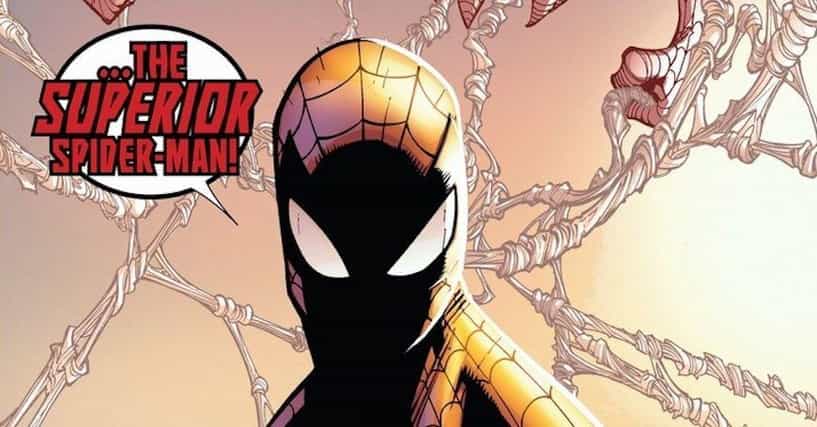Comics
Ten Weirdest Spider-Man Comics
The Wall-Crawler has appeared in some truly strange stories over the years.
Weirdest Spider-Man stories
Spider-Man has remained one of Marvel’s most popular superheroes since he first appeared back in 1962, and it would not be a stretch to say that he went on to become one of the most recognizable fictional characters of all time. Thousands of Spider-Man comics have been published over the decades, and while many of his adventures have been traditional superhero stories, the Wall-Crawler has also been featured in a number of decidedly offbeat and downright bizarre tales which really will leave readers scratching their heads. Everyone knows that Spider-Man swings through New York City and stops crooks, but it might surprise you to learn that he has also grown extra sets of arms, crossed over with characters from Nickelodeon’s Ren & Stimpy franchise, and made a deal with a literal devil. This list details ten of Spider-Man’s weirdest comics to date, and you really will start to wonder what some of the writers must have been smoking when they penned these outlandish tales.
1. Swapping bodies with Venom and with a squirrel
Spider-Man & Venom: Double Trouble
A four-issue miniseries, written by Mariko Tamaki and illustrated by Gurihiru
Although they parted off as arch-enemies, Spider-Man and Venom have since developed something of a love/hate relationship over the years. Their uneasy friendship was celebrated in the four-issue miniseries Spider-Man & Venom: Double Trouble, in which they found themselves becoming roommates due to the rising rental costs in New York City. Venom’s disgusting eating habits and his lack of cleanliness clearly bother Spider-Man, and things then become worse when the former villain then uses a device to transfer his consciousness into Spider-Man’s body to prove that he can be a hero after all. Hilarity then ensues, and things become even more bizarre when Spider-Man and Venom then find their minds being respectively transferred into the bodies of a squirrel and a cat. The minds of the animals were also transferred into the bodies of the titular heroes, and seeing Spider-Man acting like a squirrel was quite possibly one of the funniest things ever to have been published by Marvel. This was a delightfully funny miniseries from writer Mariko Tamaki, and the delicious manga-style artwork from Gurihiru was the icing on the cake.
2. Growing extra arms
The Six Arms Saga, The Amazing Spider-Man #100-102
Written by Stan Lee Roy Thomas, illustrated by Gil Kane
As you probably could have guessed from the title, this Amazing Spider-Man story arc focused on Spider-Man growing four extra arms, which really was just as bizarre as it sounds. The extra appendages appeared on Spider-Man’s body as a result of a serum he created in an attempt to remove his powers, as he blamed himself for the death of Gwen Stacey and believed he no longer deserved his incredible abilities. A significant portion of the story arc then consisted of Parker canceling social engagements and hiding from society to hide his disfigurement, before a sample of blood from Morbius the Living Vampire eventually returns him to normal. It might be jarring for some fans to see the stunningly handsome Peter Parker transformed into a monstrous six-armed freak, so The Six Arms Saga is a story that certainly has the potential to traumatize readers.
3. Teaming up with Ren and Stimpy
The Ren & Stimpy Show Vol 1, #6
Written by Dan Slott, illustrated by Mike Kazaleh
Marvel obtained the rights to publish Ren & Stimpy comics in the early ‘90s, so fans were treated to an exceptionally strange comic in which Spider-Man teamed up with Powdered Toast Man, the signature superhero from Nickelodeon’s edgy cartoon series. And to make matters even more unusual, this comic was penned by Dan Slott, who went on to become a prominent writer of The Amazing Spider-Man. This was one of the first times Slott had written the character, and goodness knows how he likes to remember this comic.
The number of weird things which occurred during this twenty-two-page story is far too numerous to list here, but a few examples include Spider-Man serving Ren and Stimpy toast sprinkled with web fluid for breakfast, a fight between Spider-Man and Powdered Toast Man in which the bread-themed hero uses sharpened slices of toast as projectile weapons, and Stimpy demonstrating his ‘superpower’ of choking up a barrage of hairballs. Spider-Man even asks himself if the bizarre occurrences are happening because he sniffed too much web fluid, and readers will no doubt be asking themselves the same thing.
4. Being outsmarted by Rhino
Flowers for Rhino, Spider-Man’s Tangled Web #5-6
Written by Peter Milligan, illustrated by Duncan Fegredo
Spider-Man’s Tangled Web was an ongoing series focusing on supporting Spider-Man characters, with Spidey himself usually only making brief appearances in each issue. The series was penned by writers who were also not usually known for writing Spider-Man comics, which served as a reminder that the book was intended to offer an examination of Spider-Man and his supporting cast from the perspective of outsiders.
One of the more unusual Tangled Web storylines was Flowers for Rhino, in which Rhino undergoes a medical procedure to increase his intelligence so that he can impress the daughter of a mafia boss, who he had become infatuated with. Rhino is often viewed as one of Spider-Man’s most dim-witted foes, so it was almost unnerving to read a story in which he transformed into a philosopher who quotes classical literature and questions whether the concept of love is nothing more than a ‘sociopaternalistic hiccup’.
After realizing that the woman he loved actually liked him for who he was and that he did not need to raise his intellect to make her fall for him, Rhino decides to have a second operation to reverse the effects of the first procedure, which changes him back into his old and idiotically rampaging self. As with most Tangled Web comics, Spider-Man only showed up in a handful of scenes, and it was particularly creepy to see the hero confronting his nemesis and being horrified to discover that his formerly idiotic foe had discovered his secret identity as Peter Parker through the use of an advanced algebraic equation. Seeing as there have not been many stories focusing on Rhino, it goes without saying that Flowers for Rhino was an enjoyably offbeat insight into the psyche of the most imbecilic member of the Sinister Six.
6. Swapping bodies with Doctor Octopus
The Superior Spider-Man, an ongoing series from 2013 to 2014
Written Dan Slott, illustrated by Ryan Stegman, Humberto Ramos, and Giuseppe Camuncoli
This ongoing series saw Spider-Man’s body being inhabited by Doctor Octopus after Peter Parker was killed at the end of the Dying Wish storyline. Putting his villainous ways behind him, Octavius vows to honour Parker’s legacy by continuing to serve as a protector of the innocent, with varying results. Seeing as Octavius is usually depicted as an obsessive mad scientist who cares for little other than his elaborate schemes, it was also hilarious to see him attempting to imitate Spider-Man’s charismatic and fast-talking persona, something which Octavius himself admits he was not very good at. At one point, he even attempts to insult a young criminal he apprehends by comparing him to Justin Bieber (who he mistakenly refers to as ‘Justin Bieker’), before explaining to the perplexed crook that he was trying to make a popular culture reference.
Jokes aside, Octavius was also far more ruthless as Spider-Man than Parker could ever have been, as evidenced by how he mercilessly gunned down the villain known as Rampage instead of taking him into custody. It could also be argued that Octavius was also more effective than Parker when it came to protecting New York, as his army of Spider Bots alerted him to crimes and emergencies occurring throughout the city, allowing him to assess how to respond to each situation. This created a stark contrast when compared to Parker’s usual method of randomly patrolling neighbourhoods in the hopes of stumbling across a situation requiring his assistance. But regardless of whether you think Peter Parker or Otto Octavius were more effective heroes, this series is worth visiting just for the sheer weirdness of Doctor Octopus attempting to become Spider-Man.
7. Entering a world of floating islands and fighting a sinister demonic creature
Spider-Man: Hooky, Marvel Graphic Novel #22
Written by Susan Putney, illustrated by Bernie Wrightson
Originally published as part of the Marvel Original Graphic novel series, this truly bizarre story finds Spider-Man being transported to a parallel dimension known as Cloudsea, which resembles a fantasy world filled with magical floating islands. During his stay in this baffling world, Spidey finds himself battling a hideous monster known as the Tordenkakerlakk, which resembles something from one of H.P. Lovecraft’s worst nightmares. Upon learning that the Tordenkakerlakk was created to hunt the benevolent sorceresses known as Marandi Sjorokker, the Wall-Crawler does whatever it takes to defeat the grotesque creature in order to protect Sjorokker, and the action sequences where he battles the monster atop a floating pirate ship were beyond thrilling.
Hooky was truly one of Spider-Man’s most unashamedly confounding adventures, and fans who are looking for a less conventional setting featuring their friendly neighbourhood Spider-Man should track it down immediately.
7. Unmasking himself to the world
Civil War #2
Written by Mark Millar, illustrated by Steve McNiven
Fans had been wondering for decades what would happen if Spider-Man revealed his secret identity to the world, which finally happened in the second issue of Civil War. After the Superhuman Legislation Act passes through Congress, Spider-Man, who had previously allied himself with pro-registration activist Tony Stark, unmasked himself during a press conference, and the results were just as shocking as you would expect. Seeing as Peter is known for being one of Marvel’s least egotistical heroes, he clearly was not prepared for the level of fame he was subjected to after his identity became public, or for the lawsuit he faced from his former employers at the Daily Bugle.
After coming to question the methods used by Tony Stark to hunt down and detain heroes who refused to comply with the Registration Act, Peter eventually changes sides and fights with the heroes who refused to register, becoming a wanted fugitive in the process. And while his identity eventually became secret again due to the deal he made with Mephisto in the infamous One More Day storyline (see the next entry on this list), it goes without saying that Civil War offered fans a unique insight into what would happen if the public finally learned that Peter Parker was Spider-Man.
8. Making a deal with a devil
One More Day, consisting of The Amazing Spider-Man #544–545, Friendly Neighborhood Spider-Man #24, and Sensational Spider-Man (vol. 2) #41
Written by J. Michael Straczynski and Joe Quesada, illustrated by Joe Quesada
One of the most widely maligned moments in Spider-Man’s history came in the One More Day story arc, where the web-slinging hero made a deal with the demon known as Mephisto in an effort to save the life of his beloved Aunt May, who had been critically injured by an assassin using a sniper rifle. The exact details of Spider-Man’s pact with Mephisto were not initially revealed, although it was later clarified that Mephisto agreed to save May’s life in return for erasing Peter and Mary-Jane’s marriage and all their memories of each other. Fans reacted overwhelmingly negatively to this comic because they believed that Spider-Man would never make a deal with the devil and that his actions throughout the book were a complete betrayal of the character. But whether you love it or hate it, this is still the only time Spider-Man has ever made a pact with a demonic entity, which makes One More Day a unique entry into the wide pantheon of Spider-Man comics.
9. Hunting a Wendigo in the Canadian wilderness
Perceptions, Spider-Man 1990 series #8-12
Written and illustrated by Todd McFarlane
Spider-Man is known for fighting criminals in New York City, so it might surprise you to learn that he actually travelled to the Canadian wilderness to stop a bloodthirsty creature from Native American mythology from claiming more victims. Writer and illustrator Todd McFarlane was responsible for an acclaimed storyline called Perceptions, which formed part of his ongoing Spider-Man series throughout the early nineties, which was published concurrently alongside The Amazing Spider-Man. The story found Peter Parker being sent on a work assignment by The Daily Bugle to investigate a child killing in rural Canada, with Wolverine also arriving in the same small town to conduct his own investigation. The body count gradually begins to his, forcing the two reluctant heroes to form an uneasy alliance in order to solve the mystery.
And while the Wendigo does indeed play a role in the story, the revelation of the real culprit behind the killings will no doubt have readers questioning who the real monsters in society are. This was a surprisingly thought-provoking tale of loss and revenge, with the overall message of how even respected members of the community can secretly turn out to be responsible for hideous acts no doubt leaving a lasting impression on readers. It was certainly not as lighthearted as Spider-Man’s usual fare, but Perceptions was still an unforgettably moving and tragic story arc.
10. Wading through sewage
Sub City, Spider-Man 1990 series #13-14
Written and illustrated by Todd McFarlane
Seeing as he usually swings through the skies of New York City, it might surprise you to know that Spider-Man has also occasionally been known to venture underneath his beloved city as well. This happened in Sub City, which found Spider-Man travelling through the New York sewers in order to investigate a string of homeless murders. Once again published as part of Todd McFarlane’s ongoing Spider-Man series from the early nineties, this was a particularly harrowing read because it dared to shed a light on how the police hardly bother to investigate crimes committed against the homeless, which was a poignant message to be featured in a comic book at the time.
As he ventures deeper and deeper into the sewers, Spider-Man eventually learns that none other than Morbius the Living Vampire was responsible for the killings, which leads to a savage and unforgettable showdown between our hero and his bloodthirsty nemesis. While it may have been unsettling at first to see our favourite Wall-Crawler trudging through sewage instead of majestically swinging over rooftops, the story’s serious message and its effective climax made it an unforgettable read.













































Andrew Kidd
October 21, 2022 at 10:34 pm
There was a particularly ridiculous storyline around 1990 or so where he became the Hulk. Yes, really.